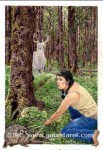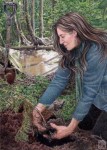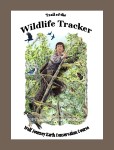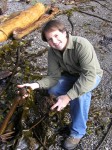It All Comes Back To Tracking – The Most Critical Outdoor Skill
If you can find it, you don’t have to make it. But what’s more, tracking is exciting as a mystery. You can discover the story of what happened in nature before you got there, so next time you’re on the trail, see if you can spot an animal track. Don’t try to identify it. At least not at first. Jumping to a conclusion about the identity of a track unwise, and it’s often not even the point. As my dad always said, “Believe nothing you hear, a third of what you read, and half of what you see.”
What I’ve discovered after 20 years tracking animals is that tracking is a chance to be a detective, to solve a mystery, and unravel a great story. A real detective assumes nothing because they know that assumption is the mother of all mess-ups, and can send innocent men to death row. The best approach to learn this discipline is by returning over and over to my study site, journaling my experiences, and looking up questions in good field guides. But underlying that process is the right attitude – an attitude of curiosity, interest, sensitivity, and love for the natural world as it was originally created.
It is in the process of investigating a tracking mystery that we gain tracking experience. So take the attitude of a detective – assume nothing, but study every clue. We must ask the question that Tom Brown, Jr., says is sacred, “What happened here, and what does it mean?” With patience, we will receive the answers. In my previous blog post, I described how his popularization of bird vocalizations can help you find, among other surprises, animals that are hidden just out-of-sight along the trail.
Start by Tracking Birds
Or, have you ever found hawk or owl feathers laying on the ground? If you want to track whether a bird was killed, look at the base of the feather shafts. If you see just feather, with no evidence of other body parts nearby, and no beak-mark at the base of the shaft, then the feather probably just fell out. If there is a beak mark on the shaft, the bird may have plucked it out itself. Some birds even do this to line their own nests and to create a heater when incubating their young.
I’ve seen time and time again raptors plucking the feathers out of their prey, leaving a beak mark that can often be seen, but otherwise no damage to the prey’s feathers. I’ve seen evidence of cougars and other felines that have killed birds, having left scissor-cuts at the base of the prey’s feathers. And I’ve seen canines just munch and slobber all over the feathers of their prey. Look at the base of a feather the next time you come across one to assess how it may have died at the scene.
Tracking is not a two-dimensional view of prints. Rather, it is a wide awareness of all that is happening in a vicinity. Use “wide-angle” vision the next time you walk into nature, and begin viewing the ground for tracks, scat, trails, and lays, as well as observing bark and fenceline barbs for tufts of fur, scrapes, nibbles, and other sign. Even the littlest, most indeterminate sign of a mammal is important.

See All The Sign: The Spoor
Scat is another very important sign to investigate in nature. You can know everything an animal ate by dissecting scat. You can look at books such as James Halfpenny’s A Field Guide to Mammal Tracking in North America to try to identify the scat, but knowing simple things such as the fact the scat will be the same width as the animal’s anus can help you identify it right away.
Also, the placement of the scat is very important. For instance, coyote scat can be found along main trails, whereas fox scat is often found at the cross of two trails in my experience. Wolf scat can be found at the corner entrance to an area and landmarks bordering its area. Domestic dog scat doesn’t have much fir and bones like the wild canines have. Domestic scat usually has cornmeal inside of it.
If you find an animal den or hole, don’t stick your hand in it, or even come close if there is a chance you may get in the way of the animal’s routine and scare it. Remember your awareness of hazards, and remember that as you gain more tracking skills, you will know better and better what effect you have on the animals, and what your safety level is.
If you find those rare, textbook tracks in some mud, sand or snow, I really encourage you to take colored popsicle sticks, or cut little twigs, and lay them about an inch to the outside of each track or sign you found. You’ll be pleasantly surprised to see how the tracks stand out in relief once you’ve done this.
See if you can determine whether a track is a front or rear, left or right, and what the “gait” of the set is – that is, whether it is running, walking extra slow, stalking, or moving at its “harmonic gait.” Even better, if you come back later, you will see how the tracks age over time, and become a better tracker as a result.
Based on the sign you found, take some time to relax and think what the “story” may have been there. Your story can be limited to the very boundaries of the track or sign you found, or you can try to include all the concentric waves of effecdt that it probably caused. Maybe you can determine those effects based on other signs you find.
When you get home, take out your tracking field guides, and put a pen to paper. Compare your story to the information you find in the books. It is also very wise to sketch the tracks quickly from memory, then journal the whole experience. It will make you a good tracker much more quickly.
 Remember, nature lovers can’t make any assumptions. Until we actually see a deer take a step, then go over and look at its print, we don’t really know what a deer print looks like, even if a field guide claims to know. I’ve read some field guides to plants, for instance, that give information which could kill you. Don’t assume that information you learn from others is true. Investigate before claiming you know anything.
Remember, nature lovers can’t make any assumptions. Until we actually see a deer take a step, then go over and look at its print, we don’t really know what a deer print looks like, even if a field guide claims to know. I’ve read some field guides to plants, for instance, that give information which could kill you. Don’t assume that information you learn from others is true. Investigate before claiming you know anything.
We are fortunate in our region to have one book that can take care of identifying all tracks, while also teaching you to understand all five arts of tracking: David Moskowitz’ new book Wildlife of the Pacific Northwest. David’s book, along with a good bird guide and Plants of the Pacific Northwest by Pojar & MacKinnon, are the only resources I carry into the field nowadays.
Exactly Like A Detective – The Tracker’s 5 Questions
Let’s start by creating some common vocabulary, with compliments to naturalist Jon Young who made a wonderful improvement to the pedagogy of wildlife tracking which he once called the Five Arts of Tracking. Simply, the arts of tracking consist of answering the five “question words:”

Question 1: Why? Habitat – If you studied ecology in college, this is the broad view of nature that your professor probably presented. You would learn why an animal would be in any given area; what food, water and shelter would available; what effect people, water, weather, geology, plants, and other animals have on an area. This kind of knowledge is critical to all the other arts of wildlife tracking, because context is key.
Question 2: When? Aging – When did an animal leave its sign? To answer this question, you will need to study the substrate, such as by pushing your thumb into the soil to determine its “give.” You will have to know how much water is in the soil, because water is what holds a track together in sand and other soft soils. Further, if you are looking at sign like bruises on a leaf, it’s important that you know how long it takes for leaf bruises to change color.
To “age” a track, it is very helpful to know the effects of recent weather in the exact spot where the animal laid its sign. It is rain, sun, wind, dew, frost and all sorts of other weather that affects how fast tracks deteriorate. Aging a track is perhaps the most challenging of the five arts, so have patience with your lack of information. In the end, you can only truly know when the track was laid if you saw the animal pass by and noted the time on your watch.

Question 3: Where? Trailing – Where did the animal go, and where did it come from? This is the art that hunting guides must know, and that search and rescue trackers focus on. They train themselves to follow the tracks of one particular species, because each species will have distinct characteristics.
To learn this art in general, I recommend mapping an area to display trails, feeding areas, bedding areas, dens, nests, scrapes, trees, plants, water and any other important markers that you can find. Noticing different kinds of trails is of particular importance to hikers and backpackers, not only to stay aware of what kinds of animals frequent an area, but to stay on human trails rather than getting side-tracked by animal trails which are notorious for getting people lost.
Or, have you ever come to a point where a trail seems to disappear? Next time it happens, think of it as a good thing, because that’s the place where you’ll become a tracker. Find a stick and measure the distance between tracks you can see. Then measure the distance to where another track or sign should be, and notice any slight disturbance you see. That’s probably your next track, and then you’ll know what “invisible” tracks look like!
Some other tricks to following tracks include looking at them from a severe angle. In other words, get down on the ground. Also, try to place yourself on the opposite side of a track from the source of the greatest light. The tracks will stand out a lot better because from that direction, you will see shadows cast within the tracks. Further, remember to use wide angle vision so that you don’t keep spooking animals without noticing. Finally, take a lot of breaks so that your eyes don’t get worn out.
Finally, you might consider joining me for a one day “trailing training” and to reach an intermediate level of expertise: 1) find a trailing specialist to do one-day training, 2) practice with your tracking partners all day, once a month, to increase awareness and build stamina against eye fatigue. 3) hire top trailing specialist Brian McConnell to do a Cybertracker Trailing Evaluation which are as much an excellent learning opportunity for intermediate to advanced trackers as anything else, and then 4) bring me or another trailer back the week before you plan to hunt, photograph, or do your conservation research.

Question 4: What? Interpretation – What was the animal doing? To answer this question, see if you can figure out front vs. rear tracks, and/or right vs. left. Then try sketching the gait pattern to figure out if the animal was pacing, stalking, trotting, bounding, loping, galloping etc. Watch out for “double register” tracks, where the rear foot goes directly into the front track. Often, there will be a succession of tracks that each look like one track, but they are really two tracks in one.
Does it seem this animal might have been eating or hunting? Does it display domestic or wild behavior? Does it display behavior of an older adult, or young animal? Does the animal seem to be in good shape, injured, or anxious? By observing animals, and then by going over and looking at their tracks, you will begin to know how tracks that are left in certain patterns can tell what an animal was doing.
Question 5: Who? Identification – Who made the track? Besides comparing your track measurements to those in a field guide, there are other things that can help you identify its maker. Always remember that you are only guessing until you have eliminated through proof all possibilities save one. To learn at the fastest past, take a Cybertracker Trailing, Track & Sign Evaluation which you can learn about via blog posts by evaluator David Moskowitz who gives a great a sense of the experience along with with links to cybertracker.org for more general info on evaluations by clicking here.
Article author Chris Chisholm is founder and co-owner of Wolf Camp and the Wolf College. If you would like to practice these skills with Chris and other staff instructors, join any of our May Workshops on Tracking Cougars & Trailing Bears, and our 5 Day Summer Expedition: Tracking Wolf Country: Birds to Big Critters or simultaneous youth camp.











